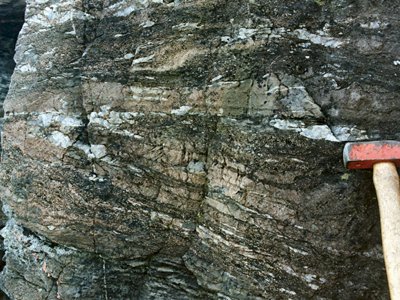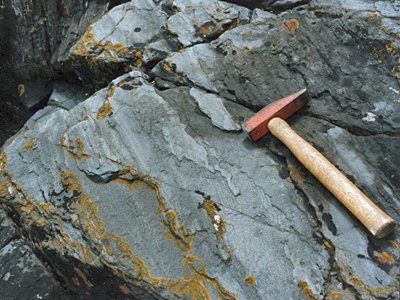Earth Science Conservation Review
| Leckpatrick Point | Antrim |
| Site Type: | Coastal section |
| Site Status: | ESCR |
| Grid Reference: | D225397 |
| Google maps: | 55.18965,-6.07659 |
| Rocks | |
|---|---|
| Rock Age: | Precambrian (Dalradian) |
| Rock Name: | Altmore Formation, Leckpatrick Green Beds, Runabay Head Formation, Southern Highlands Group |
| Rock Type: | Green beds, Grit, Psammite |
| Interest | |
Summary of site:
Most named rock divisions are defined and their characteristics described with reference to a particular outcrop which then becomes the standard of comparison for all rocks in the area of the same age. Such outcrops are called stratotypes. This locality is stratotype of the Leckpatrick Green Beds Member, the upper division of the Runabay Head Formation. The rocks form part of the Southern Highland Group, the upper division of the ancient Dalradian Supergroup.
The green beds form the great bulk of the imposing cliff at Leckpatrick Point where they are seen to rest on pinkish-brown to grey quartz and feldspar-rich grits and coarse schists. These sandy beds are part of the Altmore Formation that defines the base of the Leckpatrick member.
Over 60 m of green beds form the upper part of the cliff and vary in colour from dark to light green depending on the amounts of the green mineral hornblende. Larger crystals of the feldspar, albite and the mica, biotite also occur in the rock with a range of less important minerals. All of these rocks have undergone regional metamorphism due to burial and heating after they were formed.
Around 600 million years ago the giant continent of Gondwana began to rift under the forces of deep convection currents in the plastic rocks below the earth's crust. The giant fracture zone passed through the South Pole of the time and as it opened, volcanic rocks began to erupt into the deep, sand-filled marine basin. Volcanic dusts (tuffs) and pulverized lavas added deep layers of sediment to the ocean floor. All these beds were altered 465 million years ago to form the Leckpatrick Green Beds when the supercontinent of which they were a part, collided with a volcanic island arc. This phase of activity is called the Caledonian Orogeny and it buried all the Dalradian sediments including the volcanic beds and deformed them on a massive scale extending right across the north of Ireland and into Scotland. There are many structural features that can be seen on the cliff, associated with this burial and deformation. All the rocks of this area are overturned and face downwards because they are on the inverted, southern limb of the huge Altmore Anticline that extends into Scotland. Despite the forces involved, the grade of regional metamorphism (a measure of the intensity of change) at the site is low.
All stratotypes are important because they are the building blocks of Northern Ireland's geological history and as such should be preserved. The colour also makes the member a striking marker horizon, allowing easy recognition and large scale correlation adding international importance too.
The site lies on a coastline of extreme exposure and great care is needed in exploration. There are no immediate threats beyond the elements. The site is owned by the National Trust.
The green beds form the great bulk of the imposing cliff at Leckpatrick Point where they are seen to rest on pinkish-brown to grey quartz and feldspar-rich grits and coarse schists. These sandy beds are part of the Altmore Formation that defines the base of the Leckpatrick member.
Over 60 m of green beds form the upper part of the cliff and vary in colour from dark to light green depending on the amounts of the green mineral hornblende. Larger crystals of the feldspar, albite and the mica, biotite also occur in the rock with a range of less important minerals. All of these rocks have undergone regional metamorphism due to burial and heating after they were formed.
Around 600 million years ago the giant continent of Gondwana began to rift under the forces of deep convection currents in the plastic rocks below the earth's crust. The giant fracture zone passed through the South Pole of the time and as it opened, volcanic rocks began to erupt into the deep, sand-filled marine basin. Volcanic dusts (tuffs) and pulverized lavas added deep layers of sediment to the ocean floor. All these beds were altered 465 million years ago to form the Leckpatrick Green Beds when the supercontinent of which they were a part, collided with a volcanic island arc. This phase of activity is called the Caledonian Orogeny and it buried all the Dalradian sediments including the volcanic beds and deformed them on a massive scale extending right across the north of Ireland and into Scotland. There are many structural features that can be seen on the cliff, associated with this burial and deformation. All the rocks of this area are overturned and face downwards because they are on the inverted, southern limb of the huge Altmore Anticline that extends into Scotland. Despite the forces involved, the grade of regional metamorphism (a measure of the intensity of change) at the site is low.
All stratotypes are important because they are the building blocks of Northern Ireland's geological history and as such should be preserved. The colour also makes the member a striking marker horizon, allowing easy recognition and large scale correlation adding international importance too.
The site lies on a coastline of extreme exposure and great care is needed in exploration. There are no immediate threats beyond the elements. The site is owned by the National Trust.
| Enlander, I., Dempster, M. & Doughty, P., 2025. Leckpatrick Point, County Antrim, site summary. [In] Earth Science Conservation Review. https://www.habitas.org.uk/escr/summary.php?item=159. Accessed on 2025-04-03 |
| Previous Site | Next Site |

